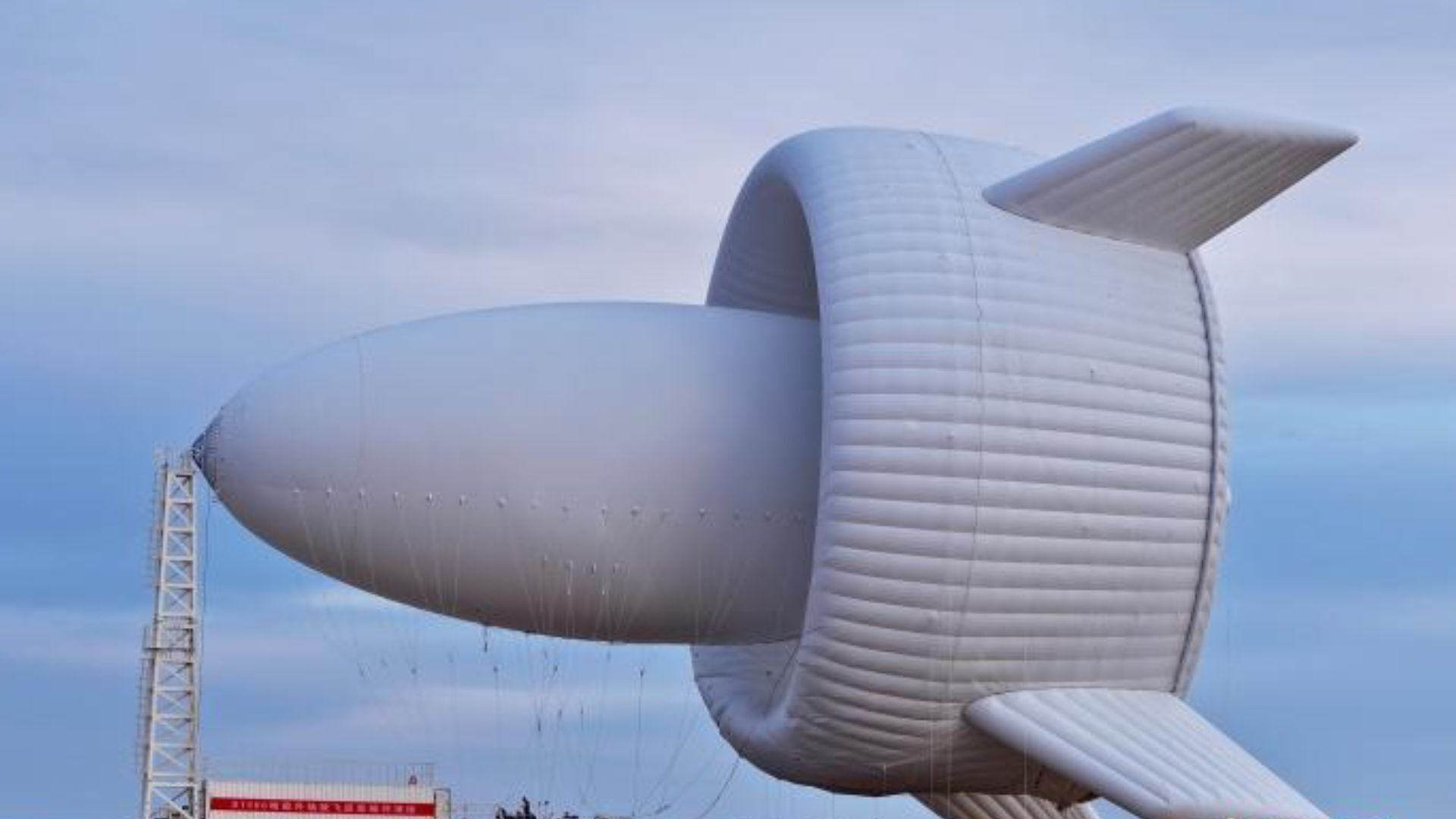"High-altitude winds between 1,640 and 3,281 feet (500 and 10,000 meters) above the ground are stronger and steadier than surface winds. These winds are abundant, widely available, and carbon-free.
"The physics of wind power makes this resource extremely valuable. “When wind speed doubles, the energy it carries increases eightfold, triple the speed, and you have 27 times the energy,” explained Gong Zeqi "
Shira, get me my god damned tea!
It’s a novel approach, but the Chinese aren’t the only ones trying to harvest energy from high winds: https://skysails-power.com/how-power-kites-work/
Promising concept too, but this is 250-500x the scale of that.
How so, when skysails talks about “Venyo harnesses the power of high-altitude winds with speeds of 13 m/s and a continuous output of up to 200 kW.” while the S1500 is featured with “Inside this duct are 12 turbine-generator sets, each rated at 100 kW.”?
It’s more like factor 5-6.Their v2 product produces about 5kw at much lower altitude (weaker 9m/s winds). 13m/s is a big ask. They don’t go as high as 1000m. I was comparing to their v2 product instead of the 200w theoretical max of their v1 product. But the blimp may not produce 1.2mw all the time either.
Yah, we need to have them running to get real numbers.
I find both approaches promising.
Ways to make electric energy available without burning fossil fuel are good.
What matters is scalability and how much material and cost you need to produce per energy unit. Kites (either parasails or fixed wing) are much simpler, can be scaled up too, and you only need a simple cable that pulls the generator’s winch. Overall kites seem much more efficient to scale up.
That looks complicated and frankly kind of stupid. Imagine trying to get something like that working without having an engineer standing by that can get everything fixed once it crashes down or something else like that happens.
Fair, but please name one single way to generate that kind of electrical power that can be fixed by a layperson in case something crashes.
At least the Chinese version doesn’t rely on as many moving parts to keep it aloft. And a complicated mechanical system to produce a flight path. The blimp itself is complicated, but it’s not a kite.
In the end the TCO (per kWh) will play a major role, especially for big installations and for smaller ones the price floor.
I suppose a helium filled blimp with 12 turbines will be more pricey than a kite with a generator. If the kite fills your need, pick that.
IDK, the benefit to the goofy kite design is that the aerial portion is far simpler - and there’s no massive energized cable hanging in the air. It’s a little… non-conventional, but it’s a great deal less complicated than floating a massive generator like the chinese solution. Downside is presumably lower energy density per unit, but the reduction in operational footprint might make the two designs competitive. It’s good people are exploring both options!
The simpler design might lead to lower prices per kWh, which will in the end play a role together with reliability, e.g min/avg power output, durability, outages.
I find it impressive how creative engineers get. Let’s hope for a third option ;)
I assume they have designed these in a way that doesn’t adversely impact migratory birds
Birds don’t fly at 3,000 feet.
The tether / power transmission line does pass through potential flight paths, tho.
Still, I imagine the impact to be even less than ground-based turbines.
Some very few do, not sure if they’re in China though.
“Windfarms hurt birds” is 90+% fossil fuel propaganda though. Yes birds run into windmills, they also run into skyscrapers and houses and antennas and planes.
We should of course look for ways to mitigate that. We should not just pretend smokestacks do no harm and not develop renewable energy projects.
Just vultures, cranes, geese, ducks, kites, swans, condors…
They’ll hire Anna Paquin, she’ll sort something out.
And her cousin, Anna penguin, the avian consultant.
That looks like a giant…
Austin Powers sketch
Very interesting development. Especially that it can be deployed in disaster zones to provide energy - if there is a strong foundation to anchor it, probably.
Wouldn’t the heavy transmission line itself act as the anchor like the chain on a cruise ship?
You are aware that a ship lays several times the depth in chain on the ground as weight. And the chain is much heavier as the tether will be, or it would not really get up high. And the distance between ship and ground is rather fixed, while the windmill blimp is in a rather floating position.
No, I think a bunch of heavy duty ground anchoring is necessary here.
On the other hand, as the Chinese are rather good at planning important things like that, I could imagine them to set up some anchor points ahead: Bury a large lump of concrete somewhere in the city. Maybe use it as an open place in a park, where nobody would notice that instead of a layer of stones it is actually going a few meters deep. Have a metal trapdor in the center where you can hook up a blimp to a connection below, and have a way to plug the power into the local grid. If catastrophy happens, drop off the blimp, blow it up and send it skywards. The park should give more than enough space to set it up.
Saw this in Big Hero Six. It’s a crazy concept. Hopefully it works.
I like how everyone conveniently leaves out the part that this is an emergency backup not actual full time scalable tool.
This one in particular: maybe.
The approach in gerenal: not so much.
Have a look here: https://skysails-power.com/systems/venyo/The one you posted is not for scaling either. I just dont see how this maintenance overhead could ever scale for mass use.
I don’t know what you mean by mass use. It’s pretty clear that these approaches are meant to add to existing solutions or provide off-grid energy at remote locations.
If you can bring a standard 30 foot container there, you can consider such a kite installation, if other requirements are met.How does an ideal site look like?
Q3: How does an ideal site look like?
The ideal site has a flat topography with no large obstacles in the prevailing wind direction, making agricultural or unused land the ideal choice. However, certain obstacles, like trees, solar power plants, or industrial facilities, are acceptable within the operating area, but specific approval may be required. We are happy to support you in identifying the perfect site for your airborne wind energy project.I don’t see, you can’t use multiple installations at different locations aka scale it.
Basically every other option will almost always be better, no? I guess we’ll see as someone actually brings some of these to the market but my guess would be that this is not going to go anywhere.
I can see those kites being used at remote locations, islands, remote villages, etc.
Add some battery to it and you have a quite reliable source of electric energy.
What option would be better in these cases in your opinion?I live in remote locations as a digital nomad and this would never really work. The maintenance overhead of even normal ground wind turbines is too much for remote areas. Solar and battery storage is really unbeatable.
Some new generation wind turbines can be decent ive heard but there are also small novel solutions like mini water turbines can be surprisingly useful.
Neither the kite based solution nor the blimp based solution is fit for the purpose of serving single or few people with electrical energy.
For that scenario some kWp based on solar can be had for cheap and some kWh battery on top doesn’t cost a fortune either.
I never insinuated that the kite or blimp are the perfect solution for every scenario - rather that it may be a match for situation that couldn’t be served well by the available means.
Cities are going to start looking like San Fransokyo (Big Hero 6) soon. Seems like an excellent idea though. If it really gets pursued, I wonder how it will interact with air travel, since I would imagine you would need no fly zones around these, at least at a certain height.
1,640 and 3,281 feet (500 and 10,000 meters)
I feel like this needs a second look.
The zero key got stuck.
They used different people’s feet.
Chinese feet are smaller.
As a European… Are feet logarithmic? Wouldn’t even surprise me that much.
Only when viewed from the north.
And on Tuesdays.
No, but feet are analogue. Hands are digital.
So that “10,000 meters” didn’t scale right, clearly. But you also can’t possibly call those “high altitudes”. Small planes like cessnas fly at low altitudes, like 2,000 - 5000 ft, a 747 flys at a high altitude, 40,000 ft; 1600 ft is nothing, that’s lower than some buildings.
Agreed. I had the same thought and then saw the numbers and was like wait, “which part of this is the fucked up part?”
they’re talking about the extra 0 on 10,000
I did catch that, I was just pointing out there are additional problems with the statement as well. But I’ve edited my statement to make that more clear.
Am I crazy or didn’t we see these in Big Hero 6?
Yes but, you see, that was an animated film aka a work of fiction. This is happening in reality.
Yeah and it’s amazing that they took this crazy idea from a kids cartoon and made it work!
a l a l a l a l h a BKinda.
I wonder what happens to the world when we take this energy from the wind? Like what are the effects of harvesting wind power?
It will impact weather patterns and severity. I’ve certainly not done the work on how much, nor do I really have a grasp on the scales involved, so that’s mostly a meaningless statement, but I can say with confidence the impact will be real. Just like dams affecting rivers, icecap mass affecting heat reflection, and solar panels increasing local temperatures.
Given that one of the impacts of global climate change has been increased weather severity and chaos, I am not afraid of positing that reducing the severity and chaos of the jet streams could be a good thing.
Similarly, there are some interesting projects going on surrounding the use of aerogel and other materials that could help focus sunlight at the top of the oceans, where evaporation can actually occur, that are focused on creating clean drinking water—and while I think this is a good end unto itself, a nice side benefit would be less solar energy reaching the ocean and raising the body temperature.
For once, it’s cool to hear about proposed industrial projects and their side effects and they’re maybe positive, instead of “well that sounds like it’s going to leech heavy metals into the surrounding community”
Of course, aerogel is horrible to work with and clogs if it doesn’t break, and nobody else has solved the problem of scaling up and dealing with the steam getting in the way. On the lightweight flying jet stream turbine front, well, I’ve been following development for 8 years and nobody has even solved the ‘limited supply of helium leaking away into space’ problem for starters. And it’s hard making an efficient generator so lightweight that it can fly. So we don’t have to worry about them potentially improving global weather severity just yet. Or potentially devastating our remaining populations of migratory birds!
Typically wind is dissipated by friction losses with the surface I think (bleeding off speed and energy by making waves, waving trees, and just rubbing against the ground) and wind is generated by heat from the sun (warm air expanding pushing against cold air, creating pressure differentials across thousands of miles).
Because wind is quick to regenerate and this does nothing to stop that the result is probably a pretty small drop in average wind speeds around the new mill and no greater ramifications than slightly less pollen travel in the spring.
While it is rather complex and hard to predict, the most likely global outcomes are fewer extreme weather events and extremely mild cooling. The hairy ball theorem tells us there’s already somewhere on the globe with no wind, so it’s not that big of a deal to convert some wind into electricity. This particular approach couldn’t convert “all” wind into electricity.
https://www.sciencenewstoday.org/spinning-skies-how-earths-rotation-shapes-our-weather – We won’t run out of wind until after we start slowing down the rotation of the earth, and we watch that pretty closely to know when to add leap seconds, and I imagine it’s an just absolutely huge store of energy in the form of angular momentum (et. al.).
I feel like all the responses you’re getting are probably generally correct in the context of wind at/near ground level. But I feel like sticking a bunch of these in a JET STREAM is (maybe?) an entirely different matter. Or at least it could be, and I too am curious what the potential ramifications are.
Jet stream winds are not just wind like any other, are they? Various jet streams have serious impacts on weather. If they harnessed and substantively bled off the Pacific jet stream, are there potentially grave consequences on the already variable El Niño and La Niña oscillation? If it could cause serious shifts in the weather, that would affect the livability of areas, create more dangerous weather conditions, and impact farming way around the globe from their wind farm installation.
Maybe none of these are genuine scientific concerns, but frankly I don’t trust China to do the science for the rest of us. Pretending these are genuine concerns, say they screw something up - it probably doesn’t too seriously impact Chinese weather as they harness the jet stream winds right at the point where it leaves their airspace. But the ramifications for the rest of the world could then be dire, and I’m not sure that is remotely a concern for them. Could be an economic advantage even. Two birds, one stone.
Things get more violent. Wind tries to find the path of least resistance, though as a fluid, so it’s taking all paths in proportion to how much resistance it has (just like electricity). If you increase the absolute resistance in one area, it reduces the relative resistance everywhere else, so you end up with increased airflow everywhere else and a reduction where you added resistance. Which means more wind outside of the turbine’s path (because it’s going to equalize that pressure differential one way or another). More flow through the same volume means higher speeds and forces (think like turning up the pressure on a tap).
But wind turbines don’t have a constant effect on wind resistance; it depends on how fast it’s spinning or how fast the wind is moving. When the wind slows, the resistance goes down, and when resistance goes down, wind speed increases. So you end up with an oscillating effect where the wind goes through cycles of strengthening, losing more energy to the turbines and weakening, which means the turbines take less energy, and the winds strengthen again. Though you’d need to be taking a significant amount of that energy to see an extreme effect like this.
Apparently taking more than 53.9% of the total wind energy in an area is enough to slow the wind to a stop (again, a violent, turbulent, oscillating stop, not a gentle end of wind).
Enough wind redirection could affect weather patterns. But we won’t run out of wind, spoiler but wind power is just indirect solar power.
To be fair everything but nuclear is just indirect solar power (and if you count other stars besides just Sol, even fission kinda is)
Edit: And I guess geothermal isn’t really solar power either, that’s residual heat from formation of the planet
Tidal too. Slows the Earth’s rotation a minuscule amount more than usual.
@Revan343@lemmy.ca @snugglesthefalse@sh.itjust.works
(And also @Mandarbmax@lemmy.world as per their other, simultaneous reply within the upper sub-thread)Isn’t the gravitational pull from the Moon part of the force behind winds? My reasoning here is something like Moon orbits the Earth -> Moon exerts gravitational pull on Earth’s oceans -> water from oceans get displaced as the Moon orbits -> water displacement displaces air -> breeze/wind.
Ya that makes sense but looking it up that doesn’t seem to be a major source of wind and I don’t know why not. Probably has an effect but is order of magnitudes weaker than solar heating and Coriolis effect (which having looked it up seems to be the #2 cause of wind).
In theory nothing. Wind is just the flow of air from high pressure to low, which itself is caused by heating from sunlight. If uncollected, the kinetic energy of the wind would eventually be lost as heat to friction between air molecules.
I feel like this should be an xkcd explains (if it isn’t already one)
I’m no scientist but I think it would take an absurd and unrealistic amount of these to have any sort of noticeable effect on average wind speeds.
The windmills will steal all the spinning from hurricanes, a bust to home owners insurance
This could be devastating to kite sales.
This looks like a good way to bring power to a remote area, and China has lots of those.
Finally the stupid floating jet engine looking turbines from Big Hero 6, except IRL they actually look good.

deleted by creator
I’d be more interested about the cable that is going to bring all that power to the ground level. With traditional tech that would weigh a shit-ton. Light weight generator would be easy peasy compared to that.
Maybe over estimate temperature deratings and maybe add a new wind speed thermal pulling capacity. But more likely forgo European and NA electrical standards entirely and submit questionables value for CE approval.
Maybe there’s energy intensive processes that they could do up there instead. Something like Haber Bosch. Then bring the products down.
City in the clouds
Will it be run by Billy Dee Williams?
Where they’re keeping my crew.
@Hodor@sh.itjust.works @iii@mander.xyz
Or, even better (considering how data centers are getting increasingly power-hungry): cloud in the clouds!
Microwave death ray to beam it down could be fun.
Local residents metallic objects would shoot sparks every now and then.
They should do a Nikola Tesla and transmit electricity wirelessly

















